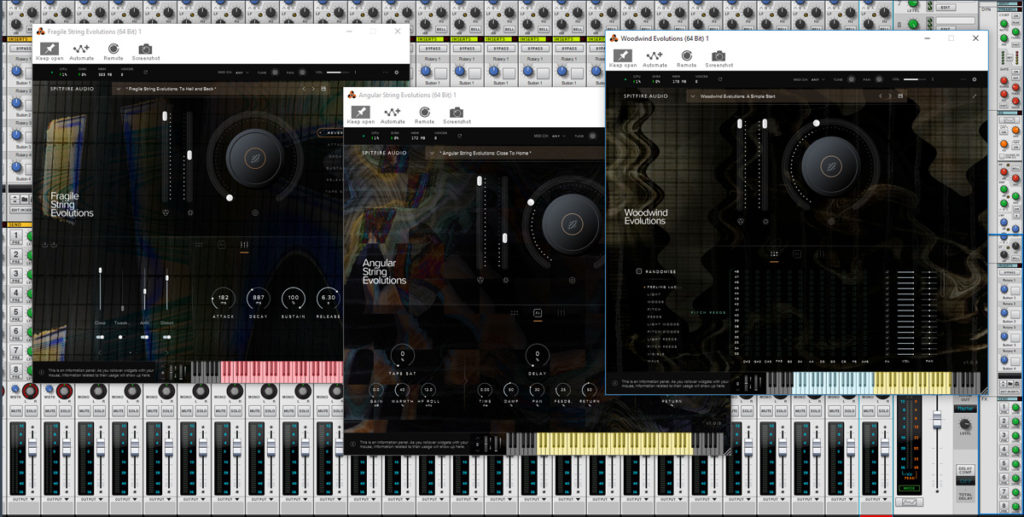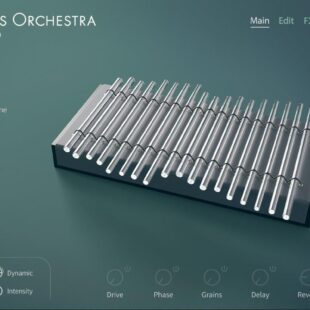SPITFIRE AUDIO EVOLUTIONS – TRIO OF EVOS
This week we take a closer look at three EVO Grid titles from Spitfire Audio, and though the functionalities of these libraries are similar due to the rather subtle nature of the evolution process, I found there is a lot to discover when layering and processing in creative ways.
As per usual, the quality of Spitfire Audio products is not in question here, but rather the flexibility and practicality of the instruments in real-world situations. EVO Grid libraries always sound pleasing, it’s whether we really need three more dedicated titles in our collection that matter.
let’s jump right in.
OVERVIEW
Spitfire Audio Angular String Evolutions, Woodwind Evolutions and Fragile String Evolutions are three separate titles combined in this review. They all share the same excellent new UsTwo partnership-designed interface with similar controls and workflow.
Effectively these new libraries replace the company’s 2015 releases EVO Grid Strings 1, 2 and Woodwind 4, moving away from the Kontakt engine to the new (and free) proprietary platform.
Angular Strings is a traditional chamber string ensemble, with a sizable selection of top players (4,3,3,3,1). The Woodwinds library contains the full gamut of wood and reed instruments, while the Fragile Strings is the unusual one of the bunch, with a more airy and delicate sound, as is indicated by the name. This library sounds ethereal and whispy almost. Right on the verge of silence.
All parts were recorded at Air Edel Studios in London by Nick Taylor using high-end recording equipment, and each weighs in at around 30GB.

FIRST IMPRESSIONS
All three titles have very dark and stylistic GUI colouring. The design mirrors the wonderful tense and menacing sounds that are easily found during my first playthrough.
I am a big fan of the new GUI even though it’s largely style over functionality. I think there’s enough room for artistic license by the designers as long as the basic workflow is solid.
Much of the interface is dominated by the enormous filter knob and twin dynamic and expression faders. Some may argue the lack of real estate left over for important things like the mic mixer, but it’s an artistic statement and rather fun, so all good with me.
All three titles share the same control functions, effect rack and microphone recording choices, so modifications made to one can be quite safely replicated across all three to keep everything in the same acoustic space.
Compared to the traditional Spitfire orchestral library there is very little extra content provided. Only a single EVO patch with around 20 or so presets contained with no individual banks or curated presets.
Of course, the magic happens within the EVO grid where, technically, millions of combinations of sounds can be made from the 48 recordings, so there is little shortage of possibilities here. I do think they could have padded out the fairly pricey products with a few loop categories and maybe a few eDNA patches as they often do on the larger orchestral library titles.
However, this lack of tangible content does make for more focus on the core function, just don’t let the price dwindle too long in your memory.
THE SOUND
EVO Grid platform instruments all share the same basic functionality – long, slow-evolving textures. The random nature of the grid makes for different timings of each sample, so they evolve happens sporadically, giving a chaotic feeling to the more extreme presets.
Depending on the luck of the roll, EVOs can sound from weird dissonant gibberish to a beautiful dance of textures interweaving naturally and at one with each other.
In my time spent playing in orchestras, to put one’s little toe out of tune would draw the immediate gaze of death from the conductor, so I can absolutely sympathise with these highly trained professional players being asked to purposely mistune, pitch and ignore tempo constraints while recording.
The clever design of the EVO Grid system means you can freely move pins around, so if you luck upon a patch that is nearly right you have the freedom to tweak the grid layout to perfection.

MADNESS IN THE METHOD
Individually, each of these libraries performs an adequate role in bringing momentum and life to long notes and chords. The random nature in both generating the EVOs and hearing them played back pairs perfectly with other, more static instruments in an arrangement.
But for me, the real wow moment is layering all three together in a menage a trois of EVO goodness. Together the libraries complement each other perfectly and create a totally new and completely immersive sound like nothing I’ve heard. Three EVO libraries playing in conjunction is as mad as it sounds, but seem to coexist quite happily together.
The real trick is in the tasteful blending of the performances. You can’t have all three on full noise unless you’re specifically going for wacky. Perhaps keeping the Fragile Strings under control while letting the Woodwind EVO experiment more with the space, perhaps pushing the distortion mics more, maybe more reverb processing.
The microphone choices play a critical role in shaping the sound and are much more useful than your traditional orchestral multi-mic affair. Being more creatively inspired, each provides a different flavour or texture to the sound that I love experimenting with.
The Tweaked mic is an extremely close source, giving amazing detail and grit to the sound. The ambience features all of the environmental properties of the room. The Distort mics are my favourite, providing an over-the-top breakup of the sound, really excellent for modern and those post-apocalyptic moments.
The final two stretched mic channels, x2 and x8, mangle the sound by time stretching the sample and then pitching it back into tune, resulting in some quite interesting particle effects, similar to a low-pass filter, but more ethereal.
The included ADSR envelope really comes into play when using these mic mixes, either changing the attack or release times completely flips the sound on its head, taking a quite recognisable instrument into something more alien and conceptual.
Excellent stuff.
If someone suggested this all as a thought experiment, I can’t imagine many taking that person overly seriously. But as with all the best ideas, they start with a lightbulb moment of madness.
In my particular workflow, these libraries act more as embellishments, a textural polish to lift ordinarily humdrum-sounding arrangements to the next level. This extra level of detail the EVO Grid provides is probably the difference between a moderately ok sounding arrangement and something a professional might add to their portfolio. At the high end of the composing spectrum, I think there are little details that make or break a commission.
CONCLUSION
Spitfire Audio have again produced an innovative and creatively fresh look at the EVE Grid system. The trio of EVOs will present plenty of inspiration for tone purists and noise-mangling destruction fiends alike.
At $ 299 USD each, this is far too much as I believe you need all three to achieve the full experience. A bundle must be in the works or else I’m afraid this must-buy trio will seriously dent your credit card. Can I choose only one to recommend? Not blimmin’ likely.
It’s all three or walks away.
For fans of this slow-evolving EVO Grid sound, these libraries represent an excellent flipside of the orchestra and one that is endlessly productive. For those thrill-seekers wanting avant-garde weirdness, there is a lot to be found here, at a price.
Another strong addition to the Spitfire Audio catalogue. Viva la EVO!
For full details and purchasing options, head on over to Spitfire Audios’ main site www.spitfireaudio.com

Like the review? Shout us a cup of coffee!






